
Void Virtuoso

A 1 mana 1/3 demon with a little bit upside that’s related to the fatigue package in this set. The card fits aggressive decks better than defensive ones, as slower decks aren’t too interested in a vanilla 1-drop. Imp Warlock should want this card if it decides to incorporate the fatigue package, with the bonus that it’s a cheap demon that can soak a Nofin’s Imp-ossible buff. Likely to be a staple inclusion.
Score: 3
Baritone Imp

If you start the game with a Baritone Imp, you will take one fatigue damage and it will turn into a 2 mana 3/3. That’s not terrible, but obviously not a card you’re too eager to put into your deck. Once you’ve played another fatigue card, this becomes decent as a 4/4 and it keeps scaling further and further into the game. We like this card and think it makes it possible that Imp Warlock will opt for the fatigue package. An early game imp that scales into the late game is not easy to find. Most 2-drops in the format don’t have the ceiling that this card does.
Score: 3
Opera Soloist

This soloist is absolutely terrible without the trigger, being a 5 mana 4/6, the card is very slow. When active, it deals Duskbreaker damage to the board. It’s a bit funny that the AOE only affects enemy minions, as if to say the fact it doesn’t hit our board matters! Nice sales pitch there, Blizzard. We’re still not buying.
The issue is that this AOE comes down on turn 5 and is still conditional on us playing a passive deck. A deck like Chad Warlock, for example, is late-game oriented but still wouldn’t be able to use this card. Furthermore, Warlock is blessed with good AOE in the upcoming format. Defile and a 3-mana Hellfire are much more valuable than Soloist. Despite Hellfire being ‘inferior’ in terms of stat output, it matters much more that it can be played as early as turn 3 and is completely unconditional. By turn 5, you might be dead at the hands of an aggressive deck. There’s a chance Warlock runs all the AOE cards, but we really don’t think it needs to.
Score: 1
Crescendo

Much like Baritone Imp, a Crescendo that deals 1 fatigue damage is very weak. As a 2nd fatigue card, it is 3-mana Consecration, which is serviceable. Once you get to 3 damage, the card is pretty nuts. This spell might feel awkward in a deck like Imp Warlock, but what makes it playable in that deck is that it only deals damage to enemies. Asymmetrical AOE effects are much more viable in aggressive decks and the fact it goes face means it can act as a finisher once it scales into the late game.
Crescendo means that the fatigue package could be a viable option for slower decks, even though the other two fatigue cards are very board oriented. What’s interesting is that you could theoretically get to fatigue, take some natural fatigue damage through life taps, and then use Crescendo as a big nuke. This sounds slow and optimistic, but it’s something to think about.
Score: 3
Demonic Dynamics

Spending 3 mana on a discover effect from a pool of mediocre minions doesn’t sound great. You’d never consider this in an aggressive deck, while slower decks should have better things to do to approach their late game. The Finale effect doesn’t seem impactful enough. Gaining +2/+4 stats across two bodies doesn’t make up for the fact we’ve spent 3 mana to do very little.
The most popular suggestion to use Demonic Dynamics is in tandem with Voidcaller. You discover the biggest demons you can find on turn 3 and then drop Voidcaller to the board on turn 4. Let’s do some math. There are 3 demons out of 13 in the discover pool that you really want (Voidcaller, Enhanced Dreadlord and Mal’Ganis). That’s an 82% chance of finding at least one of them and a 41% to find a specific one. In the case you have Voidcaller, Mal’Ganis/Dreadlord and then an undesired demon, it’s still a coinflip to get the outcome you want.
We’ll admit that these numbers could be enough to justify the card on average and it’s likely that only real playtesting with a Voidcaller package in our deck can give us the answer, but this scenario only considers Demon Dynamics on turn 3. This is the best-case scenario. Once you get to a later stage of the game, it becomes increasingly difficult to invest the mana for it. There’s one very specific usage for this card we want to try, but nothing else comes to mind.
Score: 1
Dirge of Despair

This card’s timing is a bit strange. Voidcaller has been added to the Core set, which means these cards directly compete with each other for targets. This would not be a problem if the demon package was sizeable. It would in fact be an incredible prospect for the class, but it’s likely that we only want to run Mal’Ganis and Enhanced Dreadlord as targets.
So if we have a choice, it’s always Voidcaller since it’s unconditional and comes down earlier. Dirge of Despair has a high likelihood to pull Voidcaller in such a small package too, which isn’t great. If we just had access to a Mo’arg Forgefiend, we might have given Dirge of Despair the maximum score. For now, it’s a card that is unlikely to see play.
But watch out. The moment the class gets access to another big demon in the future, it should become very strong.
Score: 2
Felstring Harp

Harp turns your self-damage effects on your turn into healing. Let’s calculate how much health this card is worth if we simply life tapped three times while it’s equipped. Instead of taking 6 damage, we’re gaining 6 life. That’s a 12-health swing for 2 mana. Even if we ignore all other synergies, this instrument seems very efficient for the cost.
Now let’s think about synergies. A turn 2 Harp into a turn 3 Hellfire is a perfect early game curve for stabilization against aggression. Flame Imp heals you for 2. Spirit Bomb becomes a cracked Touch of the Nathrezim. Turning all the fatigue damage you take through the fatigue package into healing makes that package a lot more appealing. This card seems like an auto-include in any defensive Warlock deck and might be so good that even faster decks that run a fatigue package could think about it.
Play it first. Ask questions later.
Score: 4
Crazed Conductor

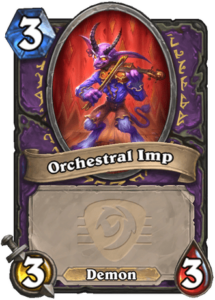
The final card of the fatigue package, Conductor is all about scaling stats. A 1-fatigue damage Conductor is a bit weak, a 2-fatigue Conductor is strong, and once you hit 3+ fatigue, Conductors become insane. Or crazed. Appropriate.
This further reinforces the fit of the package into an aggressive deck. The summoned minions are imps too, so it becomes highly appealing for Imp Warlock to have a scaling board reload card that can put a lot of stress on the removal toolkit of defensive decks.
But slower decks can also consider its inclusion since it can help them turn the corner in faster matchups. The line of play that looks to survive, stabilize, and then flip the board with a single card is something that many classes have successfully done in the past. Conductor fits that mold.
Score: 3
Rin, Orchestrator of Doom

This card looks terrible at first glance. A 5 mana 3/6 taunt is a bad body for the cost and the effect can screw yourself over just as much as the opponent. The biggest problem for the card is it both destroys cards in your hand and burns your deck. If it only affected one or the other, you might be able to funnel a win condition into one of these pools and get an advantage over your opponent.
This makes Rin a blind disruption card, meant to grief an opponent that carries late game synergies that are more curated into single cards than yours. There’s the hilarious proposition of playing Rin alongside Shallow Grave and Habeas Corpses, in order to repeatedly delete both players’ decks and hands. If this is ever a strong strategy, it’s guaranteed to get nuked from orbit with balance changes.
One thing is certain. Players will include Rin in an E.T.C band and we’ll tell you it’s terrible in a future report. You can bet money on it.
Score: 1
Symphony of Sins


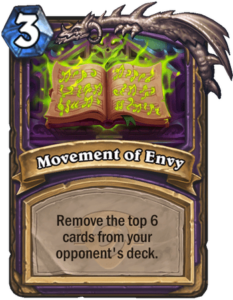

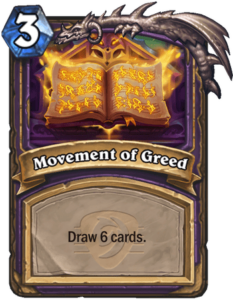
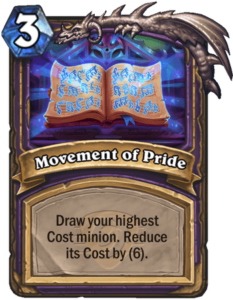


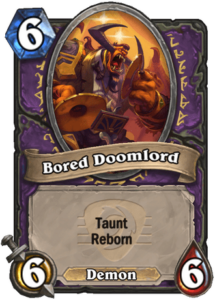
This card might single-handedly establish Warlock as the premier late game class of the format. For 6 mana, you can discover an immediate effect out of 7 choices, then shuffle the rest into your deck as 3 mana spells. All these effects are extremely powerful for 3 mana, so your deck becomes filled with high quality cards. One of them, Movement of Envy, is an intimidating clock on a slower opponent and makes it impossible to outgrind you while also giving you a very important out against combo decks. Movement of Pride can draw and discount one of your primary win conditions. In Chad Warlock, it finds Thaddius. Movement of Wrath has the strongest immediate effect in a faster matchup, but Desire and Sloth can also be helpful.
Symphony of Sins has more synergies available that are truly back breaking in the late game. Azshara’s Ring of Tides can copy one of the movements, or even the Symphony itself. Finley can help you immediately dig for the movements after you’ve played Symphony. If you want to get even greedier, Fizzle is an option.
Symphony of Sins does not instantly win you the game most times, but it makes sure that if the game goes late, the opponent is the one who’s forced to pressure and race. That makes the card meta-defining.
Score: 4
Final Thoughts
Festival of Legends Set Rank: 2nd
Overall Power Ranking: 3rd
Gul’dan is plotting Hearthstone domination. A strong Festival of Legends set combined with an incredible boost to its Core set could push the class to the forefront of the meta. Warlock looks extremely well rounded and capable of fighting effectively in both the early and late game.
Imp Warlock is losing a few pieces in rotation and might decide the Abyssal Curse package is no longer worth building around after the loss of Brann and Tamsin. However, it’s getting a new package in return that could trump the curse package in overall fit and power. The fatigue package looks like the perfect addition for the archetype, adding an early game threat (Baritone Imp), a mid-to-late game threat (Crazed Conductor), as well as an asymmetrical and scaling AOE nuke (Crescendo). Imp Warlock is an archetype that’s already not afraid to pivot to the late game if it needs to, thanks to Impending Catastrophe, so we can even see it equipping a Felstring Harp alongside Virtuoso and scaling up. Felstring Harp, by the way, is going to be an incredible card for any defensive Warlock strategy.
It might be time to start respecting Chad Warlock as a serious threat potentially sitting at the top of the meta. We don’t think it’s going to be struggling any longer. Defile is the best AOE effect Warlock has ever had. The Voidcaller package with Enhanced Dreadlord and Mal’Ganis should be a top performing package in the deck, giving it more survivability and blowout potential next to Amorphous Slime. Cover Artist is a scary proposition to copy some of these threats, with the deck looking to imitate some of the plays the class could execute back in its Kobolds & Catacombs prime.
Then you have Symphony of Sins, which is a spell that tips the late game further in Warlock’s favor, and the class could be contending to become the late game powerhouse of the format. The possibility of playing Jailer and Mal’ganis together, essentially a checkmate on any opponent that doesn’t possess non-targeted removal, has not been ignored by us either. There is a lot of space to explore when building a Control Warlock deck.
From Darkness Incarnate, Destroyer of Dreams and the Great Betrayer, Gul’dan could ascend to claim the greatest title of them all. The Gigachad.

thank you for the information